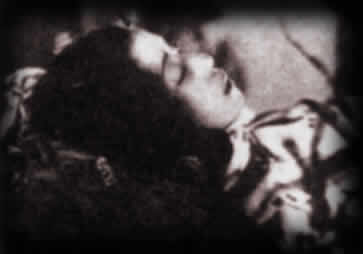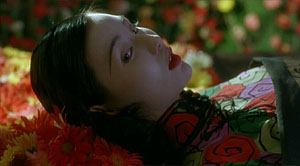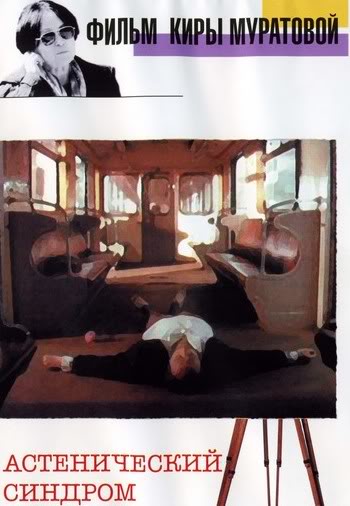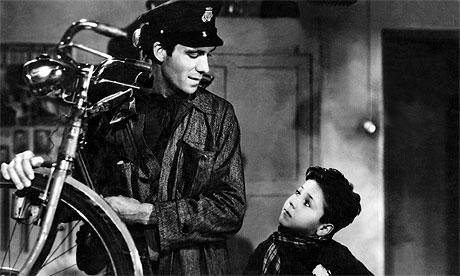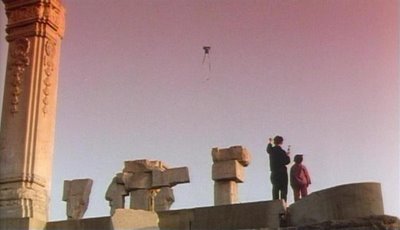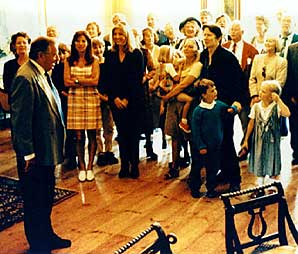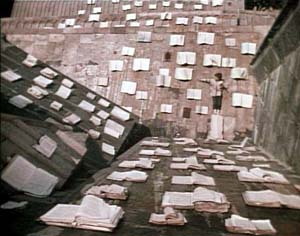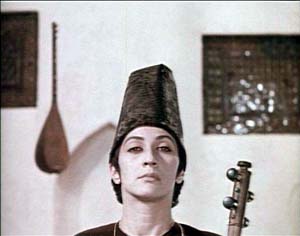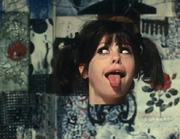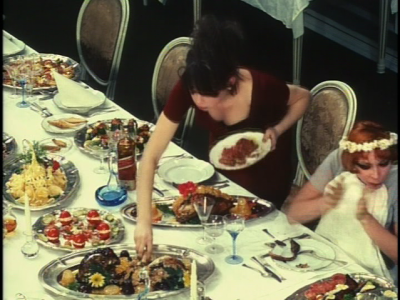These are expanded Chicago Reader capsules written for a 2003 collection edited by Steven Jay Schneider. I contributed 72 of these in all; here are the first dozen, in alphabetical order. — J.R.
Actress
Stanley Kwan’s 1991 masterpiece (also known as Ruan Ling-yu and Center Stage) is still possibly the greatest Hong Kong film I’ve seen; perhaps only some of the masterpieces of Wong Kar-wai, such as Days of Being Wild and In the Mood for Love (both of these also significantly period films) are comparable in depth and intensity. The story of silent film actress Ruan Ling-yu (1910-’35), known as the Garbo of Chinese cinema, it combines documentary with period re-creation, biopic glamour with profound curiosity, and ravishing historical clips with color simulations of the same sequences being shot — all to explore a past that seems more complex, sexy, and mysterious than the present. Maggie Cheung won a well-deserved best actress prize at Berlin for her classy performance in the title role, despite the fact that her difference from Ryan Ling-yu as an actress is probably more important than any similarities. In fact, she was basically known as a comic actress in relatively lightweight Hong Kong entertainments prior to this film, and Actress proved to be a turning point in her career towards more dramatic and often meatier parts. But the gap between her own polished star image and that of Ruan as a more unbridled tragedienne is crucial, and much of Kwan’s work as a director goes into creating a kind of nimbus around Cheung’s poise and grace. (George Cukor comes to mind as a Hollywood equivalent.) Kwan also creates a labyrinth of questions around who Ruan was and why she committed suicide — a labyrinth both physical (with beautifully ambiguous uses of black-and-white movie sets) and metaphysical. Highlights include the stylish beauty of an imagined Shanghai film world of the 30s and the flat abrasiveness of Kwan chatting with Cheung on video about what all this means and coming up with damn little. Any historical movie worth its salt historicizes the present along with the past, and this movie implicitly juxtaposes our own inadequacy with those potent clips of Ling-yu herself.
Archangel
Guy Maddin, the underground cult wizard from Winnipeg responsible for Tales From the Gimli Hospital, followed this up with an even stranger black-and-white feature (1990), made on a heftier budget. It involves amnesiac victims of mustard gas during World War I and the Russian Revolution. The hero, a Canadian soldier (Kyle McCulloch), mistakes a nurse (Kathy Marykuca) for his dead love; she’s married to a Belgian aviator (Ari Cohen) who can’t remember he’s married, and she gets so confused that she winds up mistaking the Canadian for the Belgian. There are other complications, some of which, like the amnesia, suggest a deranged remake of Random Harvest, but this film often appears to be about nothing at all — except perhaps Maddin’s obvious love for late silent and early talkie studio productions with kitschy pictorial effects, as well as offbeat surrealist conceits, such as a hailstorm of bunny rabbits falling into trenches. The results are never consistently funny or affecting — though it never seems that Maddin is out to produce straight-out comedy or camp, much less serious drama. What comes across is a fascinating fetishist delirium, where memories of remote war movies get recycled into something that’s alternately creepy and beautiful.
The Asthenic Syndrome
A great movie about the contemporary world, but far from an easy one to take or understand, because it breaks so many rules about what films are supposed to be like. Directed in 1989 by the venerable (and venerably transgressive) Kira Muratova, who was then in her mid-50s, it has been perhaps rightly called the only “masterpiece of glasnost”. It’s also the only Russian film made during perestroika that was banned by the Russian government — mainly, it would appear, for obscenity (though it wound up being shown anyway after the government sold the rights to a film club in Moscow). Beginning as a powerful, 40-minute black-and-white narrative about a middle-aged woman doctor named Natasha (Olga Antonova) who’s in an exploding, aggressive rage about the death of her husband, the film eventually turns into an even more unorthodox tale in color about a disaffected high school English teacher named Nikolai (played by cowriter Sergei Popov) who periodically falls asleep regardless of what’s happening around him. The title alludes to a form of weakness or disability that presumably encompasses both the doctor’s aggressiveness and the schoolteacher’s passivity, and Muratova evidently regards these two forms of behavior as emblematic of what’s blighted about contemporary society in general: “I don’t see any fundamental difference between us and the West,” she has said. “Mankind is everywhere, in general, the same. I see in the world a level of suffering and cruelty which surpasses understanding.”
In other words, though this tragicomic epic has plenty to say about postcommunist Russia, it’s also one of the few recent masterpieces that deal more generally with the demons loose in today’s world. It may drive you nuts — as it was undoubtedly meant to — but you certainly won’t forget it. And it’s interesting to add that at least two of Muratova’s subsequent features, Three Stories (1987) and Chekhov’s Motifs (2002), have continued the process of extreme stylization in the acting as well as the practice of squeezing together two or more fictions, both of which sharply distinguish her late work from such relatively conventional and relatively naturalistic early features as Brief Encounters (1967), in which she acted herself.
The Best Years of our Lives
This 1946 domestic epic about three World War II veterans returning to civilian life, 172 minutes long and winner of nine Oscars, isn’t considered hip nowadays, and critics as sharp as Manny Farber and Robert Warshow were pretty contemptuous of it — although seemingly from opposite political viewpoints, Farber seeing it as liberal hogwash from a conservative angle while Warshow skewered it more from a Marxist perspective. Its director, William Wyler, and literary source, MacKinlay Kantor’s novel Glory for Me (adapted here by Robert Sherwood), are far from fashionable today, and the real veteran in the cast, Harold Russell, who lost his hands in the war, occasioned outraged reflections from Warshow about challenged masculinity and even sick jokes from humorist Terry Southern many years later. But I’d call this the best American movie about returning soldiers that I’ve ever seen — the most moving and the most deeply felt. It bears witness to its times and contemporaries like few other Hollywood features, and Gregg Toland’s deep-focus cinematography is one of the best things he ever did. The rest of the cast — including Dana Andrews, Myrna Loy, Teresa Wright, Fredric March, Cathy O’Donnell, Virginia Mayo, Hoagy Carmichael, and Ray Collins — is strong too.
Part of what’s so unusual about this film as a Hollywood picture is its sense of class distinctions -— the way that the separate fates and careers of veterans who are well-to-do (March), middle-class (Russell), and working-class (Andrews) are juxtaposed. Admittedly, the fact that they all meet one another at a bar presided over by Hoagy Carmichael is something of a sentimental contrivance, as James Agee pointed out, yet the relative blurring of class lines in the armed services that carry over briefly into civilian life has its plausible side as well. Similarly, the limitations of Russell as an actor have been held against the picture, yet the fact that we accept him as the real disabled veteran that he was seems far more important, documentary truth in this case superseding the interests of fiction. The scenes between him and his (fictional) fiancée as they both struggle to adjust to their reconfigured relationship are wrenching in their tenderness as well as their honesty; there are indeed few stretches in American cinema to equal them.
The Bicycle Thief
An unemployed worker (Lamberto Maggiorani) in postwar Rome finds a job putting up movie posters after his wife pawns the family sheets to get his bicycle out of hock. But right after he starts work the bike is stolen, and with his little boy in tow he travels across the city trying to recover it, encountering various aspects of Roman society (including some of the more acute class differences) in the process. This masterpiece — whose Italian title translates as “bicycle thieves” — is generally and correctly known as one of the key works of Italian neorealism, but French critic André Bazin also recognized it as one of the great communist films. (The fact that it received the 1949 Oscar for best foreign film suggests that it wasn’t perceived widely as such over here at the time; ironically, the only thing American censors cared about was a scene in which the little boy takes a pee on the street.) The dominance of auteurist criticism over the past three decades has made this extraordinary movie unfashionable because its power doesn’t derive from a single creative intelligence, but the work of screenwriter Cesare Zavattini, director Vittorio De Sica, the nonprofessional actors, and many others is so charged with a common purpose that there’s little point in even trying to separate their achievements. This is possibly the greatest depiction of a relationship between a father and son in the history of cinema, full of subtle fluctuations and evolving gradations between the two characters in terms of respect and trust, and it’s an awesome heartbreaker. It also has its moments of Chaplinesque comedy (e.g., the contrasting behavior of two little boys having lunch at the same restaurant.) If you set it alongside something like Life Is Beautiful you start to get some notion of how much mainstream world cinema and its relation to reality have been infantilized over the past half century.
The Big Red One
The most ambitious war film in Samuel Fuller’s career (1980, 113 min.), a chronicle of his own First Infantry Division in World War II, was a long time coming. When it finally made it to the screen, a wholesale reediting by the studio and a tacked-on narration (by filmmaker Jim McBride) made it something less than Fuller originally intended. (He originally provided the studio with four-hour and two-hour cuts, both of which were rejected, and Fuller enthusiasts still hold out hopes that some day either or both of these versions might be restored. 2010 postscript: strictly speaking, the longer 2004 version prepared by Richard Schickel, which retains the narration, qualifies as neither.) But it’s still a grand-style, idiosyncratic war epic, with wonderful poetic ideas, intense emotions, and haunting images rich in metaphysical portent.
The effective cast is headed by Lee Marvin (as the grim, hardened sergeant), Mark Hamill, Bobby Di Cicco, and Robert Carradine (as the dogface who corresponds most closely to Fuller). Packed with energy and observation, it is full of unforgettable, spellbinding moments and haunting surrealist images: an inmate in an insane asylum grabbing and using a machine gun while declaring his enthusiasm for war; a protracted focusing on a corpse’s wristwatch during the Normandy landing (a sequence that Steven Spielberg was well aware of when he made Saving Private Ryan), and a soldier carrying a dead child after the liberation of one of the death camps —- an uncanny sequence that indelibly evokes the homecoming of the hero to a ghost in Kenji Mizoguchi’s Ugetsu Monogatari.
The Bitter Tea of General Yen
Frank Capra’s atypical melodrama concerns an American missionary (Barbara Stanwyck) in Shanghai –a prim New England type named Megan Davis, engaged to another missionary, her childhood sweetheart. During an outbreak of civil war, she’s taken as prisoner by a Chinese warlord named Yen (Nils Asther). For my money, the unlikely love story that ensues is not only Capra’s unsung masterpiece, but also one of the great Hollywood love stories of the 30s — subtle, delicate, moody, mystical, and passionate. Joseph Walker shot it through filters and with textured shadows that suggest the work of Josef von Sternberg; Edward Paramore wrote the script, adapted from a story by Grace Zaring Stone. Oddly enough, this perverse and beautiful film was chosen to open Radio City Music Hall in 1933. It was not one of Capra’s commercial successes, but it arguably beats the rest of his oeuvre by miles, and both Stanwyck and Asther are extraordinary in it.
Among the film’s highlights are a remarkable dream sequence in which Megan’s bedroom is broken into by a Yellow Peril monster whom one assumes is Yen, and then is saved by a masked man in western clothes whom one assumes to be her fiancé. But when she removes the mask, it turns out to be Yen, who is standing beside her when she wakes. No less memorable is the exquisite final sequence — which might be interpreted as a Hollywood brand of pop Buddhism, though it’s rendered with sweetness and delicacy.
The Blue Kite
Banned in China, the powerful eighth feature (1993) of Tian Zhuangzhuang (The Horse Thief, Li Lianying, The Imperial Eunuch) follows its fictional hero, Tietou, and his family in Beijing from 1953 to 1968, through the Cultural Revolution and its ensuing repercussions and purges. Tietou’s father is a librarian, and in one unforgettable and disquieting postrevolution scene, where a meeting is held for the library staff, the hero’s father briefly leaves the room to go to the toilet, and finds upon his return that he’s been branded a reactionary, leading to his banishment to a collective farm for “re-education,” and a radical change in his entire family’s fortunes.
The film offers a sublime and often subtle look at how history and politics disrupt ordinary lives, with a memorable use of its central courtyard location and a keen feeling for everyday life within that space. One comes away from this film with a profound sense of how individuals strive to maintain a sense of ethics within a changing society that periodically confounds those ethics or makes them irrelevant. With Zhang Wenyao, Chen Xiaoman, Lu Liping, Pu Quanxin, Li Xuejian, and Guo Baochang.
Brightness (Yeelen)
Souleymane Cissé’s extraordinarily beautiful and mesmerizing fantasy is set in the ancient Bambara culture of Mali (formerly French Sudan) long before it was invaded by Morocco in the 16th century. A young man (Issiaka Kane) sets out to discover the mysteries of nature (or komo, the science of the gods) with the help of his mother and uncle, but his jealous and spiteful father contrives to prevent him from deciphering the elements of the Bambara sacred rites and tries to kill him. Apart from creating a dense and exciting universe that should make George Lucas green with envy, Cissé has shot breathtaking images in Fujicolor and has accompanied his story with a spare, hypnotic, percussive score. Conceivably the greatest African film ever made, sublimely mixing the matter-of-fact with the uncanny, this wondrous work won the jury prize at the 1987 Cannes festival, and it provides an ideal introduction to a filmmaker who is, next to Ousmane Sembène, probably Africa’s greatest director.
The Celebration
On balance, “Dogma 95” — a Danish manifesto signed by Lars von Trier, Thomas Vinterberg, and others that calls for location shooting, handheld cameras, direct sound, and an avoidance of special effects — probably has more significance as a highly successful publicity stunt than as an ideological breakthrough, judging especially from the first two features that emerged under its ground rules, von Trier’s The Idiots and Vinterberg’s The Celebration. (It’s also worth considering that these ground rules were subsequently abandoned by both filmmakers, and that “Dogma” certificates wound up getting sold for hefty prices to qualifying filmmakers, marking the whole enterprise as a business as much as —- or perhaps even more than — an artistic movement.) Both films, in fact, are apparent acts of rebellion and daring that are virtually defined by their middle-class assumptions and dogged apoliticism. Von Trier’s movie boasts one good scene surrounded by a lot of ersatz Cassavetes; Vinterberg’s work, which is even more conventional in inspiration — think Ibsen, Strindberg, Bergman — is genuinely explosive because it’s so powerfully executed, not because it represents anything new in terms of either form or content.
In terms of technique, however, it did set some important precedents. Shot with the smallest and lightest digital video camera available at the time, The Celebration (1998) chronicles the acrimonious and violent family battles that ensue at a country manor house where the 60th birthday of the family patriarch is being observed, not long after the eldest son’s twin sister has committed suicide. The extreme forms of aggressive behavior that emerge from the onset and Vinterberg’s jagged style of crosscutting disguise the fact that this is basically a very well written, acted, and directed piece of psychodrama rather than the revolutionary experiment it was proclaimed to be in 1998. But the sheer dramatic power derived from the gradual unveiling of family secrets eventually and justifiably wins one over.
The Color of Pomegranates: The Director’s Cut
Sergei Paradjanov’s greatest film (1969) is also his most radical and obscure, and it inaugurated the most serious difficulties he had with Russian authorities that culminated in his being sent to prison in 1973, for homosexuality and other charges —- after having already been attacked as a formalist, a Ukrainian nationalist, and an ideological deviant. (He was not able to make another film for over a decade, and was only able to complete one further feature before he died of cancer in 1990.) Born to an Armenian family in Georgia in 1924, Paradjanov suffered throughout much of his life for his celebration of non-Russian cultures as well as his defiance of bureaucracy, and this ground-breaking masterpiece, also known as Sayat Nova, remains the most extreme expression of his eccentric vision.
A mystical and historical mosaic about the life, work, and inner world of 18th-century Armenian poet Aruthin Sayadin, popularly known as Sayat Nova (the “King of Song”), The Color of Pomegranates was previously available only in an ethnically “dry-cleaned” Russian version — recut by Sergei Yutkevich, with chapter headings added to clarify the content for Russian viewers. The superior original version, found in an Armenian studio in the early 90s, can’t be regarded as definitive (some of the material from the Yutkevich cut is missing), but it’s certainly the finest we have and may ever have: some shots and sequences are new, some are positioned differently, and, of particular advantage to Western viewers, much more of the poetry is subtitled.
In both versions, the striking use of tableau-like framing recalls the shallow space of movies made roughly a century ago, while the gorgeous uses of color and the wild poetic and metaphoric conceits seem to derive from some utopian cinema of the future. The opening quotation from Sayadin can be read as the director’s disclaimer: “My water is of a very special kind,/Not everyone can drink it./My writing is of a very special kind,/Not everyone can read it./My foundation’s made not of sand,/But of solid granite.” But we don’t have to decode the images in any systematic way in order to experience their haunting power. The opening shots show three pomegranates oozing red juice on a white tablecloth, a bloodstained dagger, bare feet crushing grapes, a fish (which promptly becomes three fishes) flopping between two pieces of driftwood, and water falling on books. At once “difficult” and immediate, cryptic and ravishing, the stark images throughout resemble Persian miniatures infused with ecstasy.
Daisies
My favorite Czech film, and surely one of the most exhilarating stylistic and psychedelic explosions of the 60s, Vera Chytilova’s madcap and aggressive feminist farce explodes in any number of directions. While many American and Western European filmmakers during this period prided themselves on their subversiveness, it’s possible that the most radical film of the decade, ideologically as well as formally, came from the East —- from the liberating ferment building towards the short-lived political reforms of 1968’s Prague Spring. Featuring two uninhibited 17-year-olds named Marie — whose various escapades, which add up less to a plot than to a string of outrageous set pieces, include several antiphallic gags (such as slicing up cucumbers and bananas), a penchant for exploiting several dirty old men, and a free-for-all with fancy food (rivaling Laurel and Hardy) that got Chytilova in lots of trouble with the authorities — this disturbing yet liberating tour de force shows what this talented director can do with freedom. A major influence on Jacques Rivette’s Celine and Julie Go Boating, this is chock-full of female giggling, which might be interpreted in context as what critic Ruby Rich has called the laughter of Medusa: subversive, bracing, energizing, and rather off-putting (if challenging) to most male spectators (1966).

